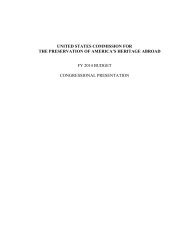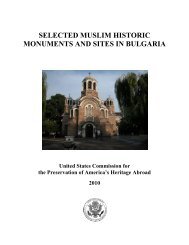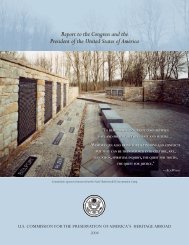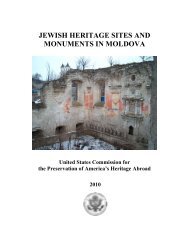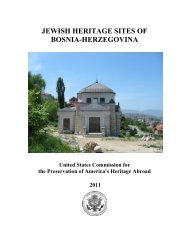jewish cemeteries, synagogues, and mass grave sites in ukraine
jewish cemeteries, synagogues, and mass grave sites in ukraine
jewish cemeteries, synagogues, and mass grave sites in ukraine
You also want an ePaper? Increase the reach of your titles
YUMPU automatically turns print PDFs into web optimized ePapers that Google loves.
Overall, there has been more effort <strong>in</strong> recent years to recognize the location of <strong>mass</strong> <strong>grave</strong><strong>sites</strong><br />
<strong>and</strong> mark the places with monuments than there has been <strong>in</strong> car<strong>in</strong>g for Jewish <strong>cemeteries</strong>. As <strong>in</strong><br />
the case of <strong>cemeteries</strong> already described, most of the work at <strong>mass</strong> <strong>grave</strong><strong>sites</strong> is sponsored by<br />
Jews from abroad – either <strong>in</strong>dividual survivors themselves mark<strong>in</strong>g the presumed <strong>grave</strong>s of their<br />
loved ones who did not escape the Holocaust, or by organizations of survivors or descendants of<br />
towns, collectively commemorat<strong>in</strong>g the dead.<br />
In 1995, fund<strong>in</strong>g from a former citizen of Odesa, who now lives <strong>in</strong> Israel, Yakov Maniovitch,<br />
helped create the memorial complex for murdered Jews <strong>in</strong> Odesa. The memorial was built <strong>in</strong> the<br />
center of the city on Prokhorovska Street. It <strong>in</strong>cludes a 250-meter walkway <strong>and</strong> a<br />
commemorative obelisk. In Yalta <strong>in</strong> the Crimea, funds were be<strong>in</strong>g sought <strong>in</strong> the mid 1990s to<br />
secure a <strong>mass</strong> <strong>grave</strong>site that was <strong>in</strong>creas<strong>in</strong>gly be<strong>in</strong>g exposed by erosion <strong>and</strong> neglect. The site<br />
conta<strong>in</strong>s rema<strong>in</strong>s of as many as 4,000 people executed <strong>in</strong> December 1941. It had been hidden<br />
until heavy ra<strong>in</strong>s exposed hundreds of thous<strong>and</strong>s of bones <strong>in</strong> 1994. 54<br />
Follow<strong>in</strong>g are several examples of <strong>mass</strong> <strong>grave</strong>s identified <strong>in</strong> the survey. The <strong>in</strong>formation<br />
concern<strong>in</strong>g these <strong>sites</strong> is typical of the results found <strong>in</strong> the survey. Attempts were made to locate<br />
the <strong>sites</strong>, <strong>and</strong> describe their overall condition, ma<strong>in</strong>tenance, <strong>and</strong> visibility. A complete list of all<br />
<strong>mass</strong> <strong>grave</strong>s visited is <strong>in</strong> Appendix IV.<br />
‣ In Novo-Uman (Mykolaivska oblast), the <strong>mass</strong> <strong>grave</strong> is unprotected. It is known that<br />
Hasidic Jews are buried there, but no data about the precise number of persons <strong>in</strong>terred nor their<br />
<strong>in</strong>dividual identities has been found. There are no signs mark<strong>in</strong>g the boundaries, <strong>and</strong> vegetation<br />
around the <strong>grave</strong>s grows freely. The <strong>grave</strong> has been v<strong>and</strong>alized with<strong>in</strong> the past ten years, but the<br />
municipality, which owns the site, has not erected a fence to protect it. The <strong>grave</strong> is currently<br />
used for agricultural purposes: graz<strong>in</strong>g <strong>and</strong> grow<strong>in</strong>g crops.<br />
‣ In Nizhyn (Chernihivska oblast), there is no sign explicitly mark<strong>in</strong>g the <strong>mass</strong> <strong>grave</strong> but a<br />
fence surrounds the site. It has protected the <strong>grave</strong> from v<strong>and</strong>alism. The <strong>grave</strong> itself is <strong>in</strong>dicated<br />
by a s<strong>in</strong>gle <strong>grave</strong>stone that serves to commemorate all the victims. The site attracts occasional<br />
visitors on organized tours. The municipality, which owns the site, has periodically sent<br />
personnel to clean the site.<br />
‣ Nemyriv (V<strong>in</strong>nytska oblast) conta<strong>in</strong>s four <strong>mass</strong> <strong>grave</strong>s. None is protected, but all are<br />
marked by signs mention<strong>in</strong>g the Holocaust. Nazis murdered the residents of the Nemyriv ghetto<br />
between 1942 <strong>and</strong> 1944. Organized <strong>in</strong>dividual tours, private visitors, <strong>and</strong> local residents<br />
occasionally visit. The authorities occasionally clear <strong>and</strong> clean some of the <strong>grave</strong>s <strong>and</strong> work to<br />
ma<strong>in</strong>ta<strong>in</strong> the tombstones. At one <strong>grave</strong> to the north of Nemyriv near a quarry, local Jews worked<br />
every year between 1950 <strong>and</strong> 1980 to restore the stones that are present at the site. None of the<br />
<strong>sites</strong> have been v<strong>and</strong>alized, but walls or fences do not protect them.<br />
‣ In Andrushivka (Zhytomyrska oblast), there are two <strong>mass</strong> <strong>grave</strong>s that have been well<br />
ma<strong>in</strong>ta<strong>in</strong>ed by local authorities. One is <strong>in</strong> the southeastern part of town, near the hospital. The<br />
other is close to an important road – Andrushivka-Pavelky Road. Each is surrounded by a fence,<br />
but neither has a gate. Each has a sign mention<strong>in</strong>g the Holocaust. Few people visit the <strong>sites</strong>, but<br />
54 “Rema<strong>in</strong>s of Victims Exposed <strong>in</strong> Crimea,” JTA article published <strong>in</strong> American Jewish World, 83:3 (September 23,<br />
1994).<br />
57




